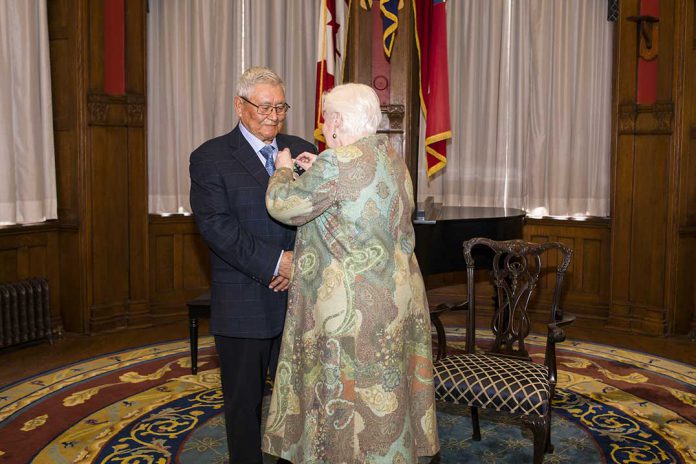LITTLE CURRENT—A proposed zoning amendment bylaw in the Northeast Town has been met with a great deal of concern from many parties, including the United Chiefs and Councils of Mnidoo Mnising (UCCMM), who were represented at the Tuesday night meeting.
As has been reported previously, council has spent some months reviewing a change to the designation of shoreline residential islands and Crown lands on islands. The islands in question are specific to the region of McGregor Bay and Bay of Islands.
Part two of the zoning bylaw amendment stated that all Crown land in the Bay of Islands and McGregor Bay are zoned as ‘open space conservation’ with the following uses permissible: an area where the primary land use is for public recreation or conservation use.
During the public portion of the meeting where comments regarding the zoning bylaw amendment were sought, Aundeck Omni Kaning Chief Patsy Corbiere, also representing the UCCMM, addressed mayor and council saying that the UCCMM member First Nations should have been consulted on the zoning bylaw amendment as it pertained to islands that are involved in a decades-old land claim, the 1990 land claim agreement, and chastised council for not involving them in the discussion process.
Matt McPherson, UCCMM lawyer with the firm Olthius, Kleer, Townsend LLP, also spoke to council, telling them “the bylaw must be deferred” as it was not in ordinance with the municipality’s Official Plan, nor did it take into account the land claims currently before the courts.
Mr. McPherson explained that the First Nations used the islands long before Europeans came and noted the lake bed and islands claims, which he said the Northeast Town should be aware of.
He reminded council that the First Nations people of the area continue to use those islands for things such as fishing, hunting, ceremonies and medicine gathering.
According to a report solicited by the UCCMM, a planning expert noted that under the new bylaw, buildings that were once not permitted would be allowed. The expert goes on to state that the new zoning bylaw does not create a disincentive which could mean the potential for the creation of larger buildings, boathouses and more water traffic.
“First Nations have to be consulted before a bylaw such as this is passed,” Mr. McPherson stressed. “Other than receiving the public notice of this meeting, there’s been no consult with First Nations.”
The lawyer again told council that the bylaw “must be deferred” until that consult occurs.
“We just want to be consulted,” said Chief Patsy Corbiere. “The Trudeau government has been pushing this, consultation with First Nations, plus you need to follow your own laws.”
Terry Debassige also addressed mayor and council on behalf of the M’Chigeeng First Nation. He told council that he was sent on behalf of Chief Linda Debassige, who was “very concerned” by the bylaw.
He noted that his council wanted to run a power line from the community wind towers along a road allowance, but was not granted permission because of the 1990 Manitoulin Land Agreement.
“Where do you get your powers to do this when we were told we can’t because the 1990 Manitoulin Land Agreement hasn’t been settled?” he queried, also noting the lake bed claim.
“It’s very concerning that people seem to think things are settled,” Mr. Debassige added.
Councillor Michael Erskine noted that his council had gone through a public meeting process, as well as sending out letters to the adjoining First Nations advising them of such. “So what is the process we’re supposed to follow?” he asked. “If not asking for input, then what?”
CAO Dave Williamson explained that the municipality had sent out letters, “But let’s ask our neighbours what that process should be.”
Councillor Bill Koehler said he thought that following the evening’s presentations, the motion should be deferred.
Councillor Laurie Cook explained that the whole intent behind the zoning bylaw amendment was to protect the islands and to create a disincentive.
Mr. Williamson told council they had a few options.
“If you do defer, it comes at a cost,” Mr. Williamson explained. “You have to ask yourself, will the impact of this amendment be worth the cost? We’ve spent $3,000 so far, and believe me it’s going to get higher.”
Mr. Williamson warned council that should they proceed and be taken to court, this would also come with a hefty price tag.
He noted that the McGregor Bay Association, Bay of Islands Community Association, area contractors, Ministry of Municipal Affairs and Housing, the Ministry of Natural Resources as well as the UCCMM all have concerns with the bylaw amendment.
“Or,” the CAO added, “you can put it on the table and defeat it at no cost.” If the change is defeated, the bylaw would simply revert to its original form.
Mr. Williamson also explained that should residents of the area want a zoning change, they would simply have to come before the planning planning authority and request a change.
Councillor Jim Ferguson made a motion to move the bylaw amendment (as a means of getting it on the table), seconded by Councillor Bill Koehler.
Councillor Ferguson noted that the views heard that night showed that there was no support for the bylaw and said it was “wasting taxpayers’ dollars.”
Councillor Cook pointed out that the number of islands affected by this are few and far between.
In a recorded vote, all of council voted against the motion and it was defeated.
“Chief Corbiere, we’ll try to do better,” Mayor MacNevin said of the consultation process.
Chief Corbiere responded that they are neighbours and friends and suggested council create a consultation protocol.
The proposed zoning bylaw amendment would have renamed the existing ‘shoreline residential – restricted’ zone to ‘shoreline residential – islands’ and would allow the following only: a single attached dwelling, a garden suite (subject to section 7.1.3), a secondary unit (subject to section 7.1.3), home occupation use, a public park, a playground, a public utility or a bed and breakfast.
The new shore residential – islands zone would have the following provisions: minimum lot frontage, 60 metres; minimum lot area, 8,093 square metres; minimum lot coverage, five percent; minimum front yard, 10 metres; minimum rear yard, three metres; minimum interior side yard, three metres; minimum exterior side yard, 7.5 metres; maximum building height, nine metres; minimum distance to a lot line for an accessory building, three metres; maximum building height for an accessory building, five metres; and maximum building floor area for an accessory building, 89 square metres.





